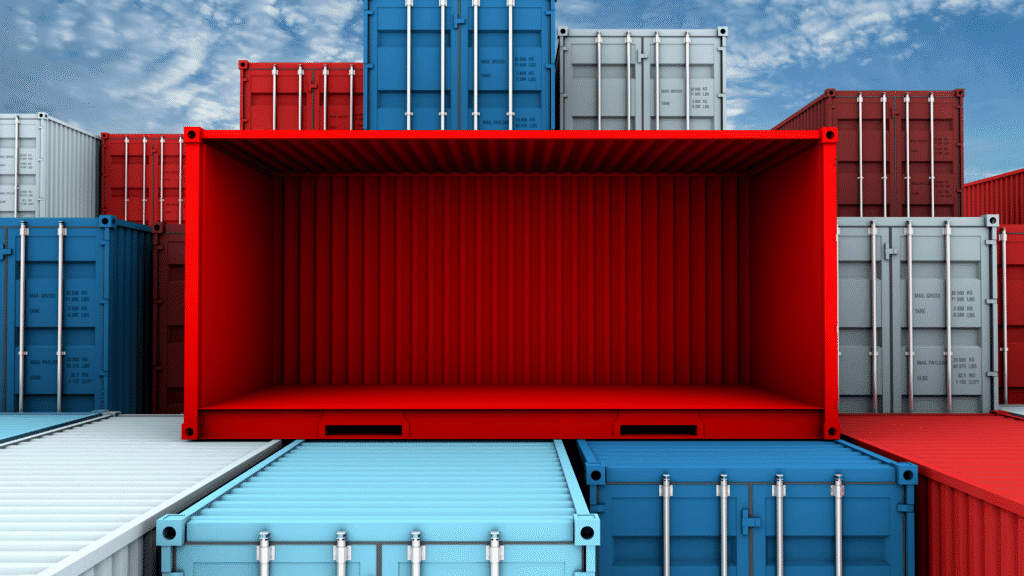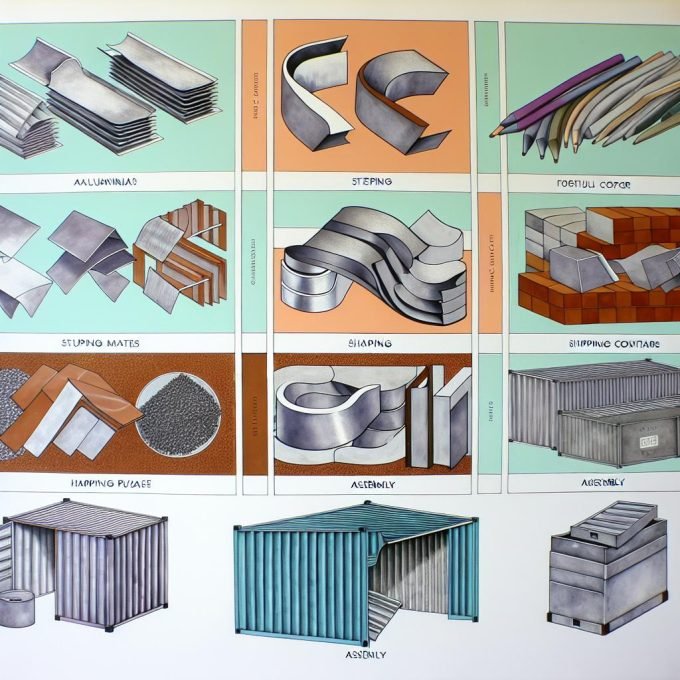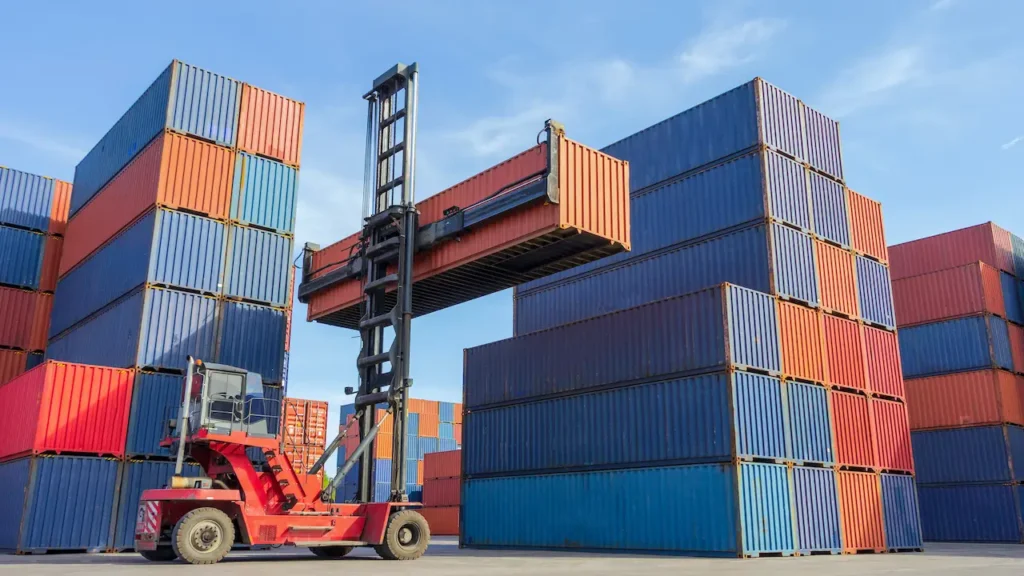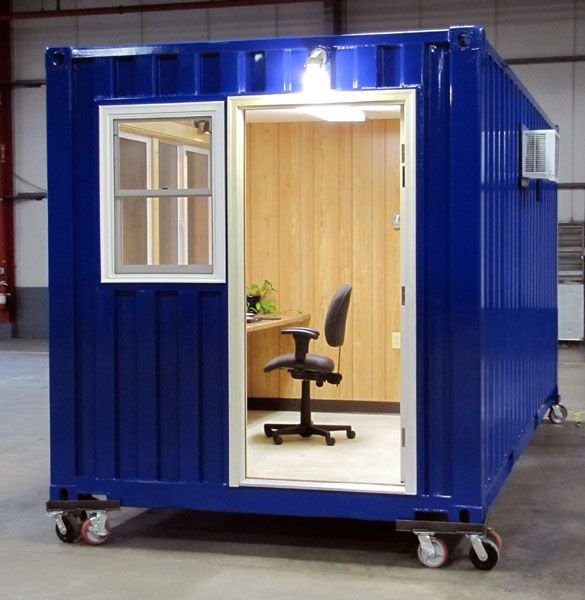What is a Shipping Container, and How is it Commonly Used?
Table of Contents
ToggleA shipping container is a large, standardized steel box designed for transporting goods securely across long distances. These containers are used extensively in international trade, allowing cargo to be moved seamlessly by ships, trucks, and trains. Shipping containers are highly versatile; besides carrying raw materials, machinery, electronics, or consumer products, they are also repurposed for storage facilities, modular offices, and even eco-friendly homes. Their durability, cost-effectiveness, and ease of transport have made them indispensable to global logistics and construction industries.

What are the Standard Sizes of Shipping Containers Available?
Shipping containers come in standardized sizes to ensure compatibility with ships, trucks, and cranes worldwide. The most common sizes are
- 20-foot container (Standard/TEU): Around 20 feet long, 8 feet wide, and 8.6 feet high.
- 40-foot container (FEU): Approximately 40 feet long, 8 feet wide, and 8.6 feet high.
- 40-foot High Cube container: Same length and width as the standard 40-foot, but taller at 9.6 feet.
- 45-foot High Cube container: Offers additional space for oversized cargo.
These sizes enable shipping companies to accurately calculate capacity, allowing goods to be transported via different modes without requiring repacking. Forever Engineering LTD offers these sizes to meet the diverse requirements of various industries, including commercial and residential applications.
What are the Benefits of Using Shipping Containers?
Shipping containers offer a wide range of advantages that explain their widespread use:
- Standardization – Containers follow global dimensions, making international shipping efficient and organized.
- Durability – Made from high-strength steel, they withstand harsh weather, corrosion, and rough handling.
- Cost Efficiency – Containers reduce the need for excessive packaging and handling, lowering shipping costs.
- Security – Containers can be locked and sealed, protecting cargo from theft and damage.
- Versatility – Beyond shipping, containers are repurposed for storage units, construction projects, pop-up shops, and residential housing.
- Sustainability – Repurposing old containers helps reduce environmental waste, making them eco-friendly building blocks for modern projects.
How Much Weight Can a Standard Shipping Container Hold?
The weight capacity of shipping containers varies by size:
- 20-foot container: Can typically carry up to 28,000 kg, around 62,000 lbs, of cargo.
- 40-foot container: Can carry up to 28,000–30,000 kg, similar to the 20-foot, but with more space for lighter cargo.
- High Cube containers: Offer the same weight limits but provide more volume for bulky, lightweight goods.
It’s important to distinguish between tare weight (the empty container’s weight), payload capacity (maximum cargo weight), and gross weight (container plus cargo). International safety regulations ensure containers are not overloaded.

What Materials Are Shipping Containers Typically Made From?
Shipping containers are built to be strong, durable, and weather-resistant. The primary materials include:
- Corten Steel (Weathering Steel): The most common material, designed to resist rust and corrosion while withstanding rough sea conditions.
- Aluminum: Lighter than steel, often used in refrigerated or specialized containers.
- Wood Flooring: Usually marine-grade plywood or bamboo, treated to resist pests and moisture.
- Protective Coatings: Anti-corrosion paints and sealants extend the lifespan of the container.
This construction ensures containers remain secure and functional even after years of heavy use. Forever Engineering LTD sources containers made with durable steel to ensure maximum strength and longevity.
How Long Does a Shipping Container Usually Last with Proper Maintenance?
The lifespan of a shipping container depends on usage, environment, and maintenance. On average:
- In active shipping service: Containers last 10–15 years due to constant exposure to seawater and handling.
- When repurposed for storage or construction: Containers can last 25 years or more with proper care.
Regular maintenance, such as painting, repairing dents, and protecting against rust, greatly extends their usability. Many repurposed containers have been converted into long-lasting homes, offices, and industrial facilities, proving their durability well beyond their shipping years. Forever Engineering LTD provides guidance on maintenance practices such as painting, rust protection, and regular inspections to extend the container’s lifespan.
How do Shipping Container Homes Compare to Traditional Houses in Terms of Cost and Durability?
Shipping container homes have become increasingly popular as an affordable and eco-friendly housing option. Compared to traditional houses, container homes are often much more cost-effective.
| Aspect | Shipping Container Homes | Traditional Houses |
| Cost | Lower cost; can be built for ৳2,360,000 – ৳7,080,000 depending on design.
| Higher cost; often ৳11,800,000+, depending on size and materials.
|
| Construction Time | Faster; can be completed in weeks to a few months. | Slower; usually takes several months to years. |
| Durability | Strong steel structure; lasts 25–30 years or more with maintenance. | Long lifespan (50+ years) but requires higher upkeep. |
| Customization | Limited by container shape but can be stacked/modified. | Highly flexible in design and layout. |
| Eco-Friendliness | Sustainable option by reusing containers. | Depends on materials used; often less eco-friendly. |
What Security Features are Available for Shipping Containers?
Shipping containers are known for their robust security, which is one of the reasons they are trusted for transporting valuable goods worldwide. Common security features include:
- Locking Bars: Heavy-duty steel bars secure the doors from top to bottom.
- Padlock Boxes: Reinforced steel boxes cover padlocks, preventing tampering or bolt-cutting.
- High-Security Padlocks: Weather-resistant locks that provide extra protection.
- CCTV and Alarm Systems (Optional): Many businesses add surveillance and alarms for additional safety.
- Seals and Tags: Used in shipping to detect unauthorized access.
When repurposed for storage or homes, shipping containers can also be reinforced with steel doors, window grills, and motion sensors, making them as secure—if not more secure—than many traditional structures. Forever Engineering LTD provides containers with customizable security features to keep goods and belongings safe.

What Industries Commonly Use Shipping Containers?
Shipping containers are not limited to the logistics industry; they are widely used across multiple sectors:
- Shipping & Logistics: The primary industry, transporting goods across sea, rail, and road.
- Construction: Containers serve as site offices, storage units, and modular building blocks.
- Retail: Pop-up shops, cafés, and kiosks often use containers for quick, low-cost setups.
- Hospitality: Many hotels and restaurants are designed using modified containers.
- Agriculture: Used for mobile storage, refrigerated transport, and even vertical farming.
- Emergency Relief: Containers are converted into shelters, clinics, and mobile hospitals during disasters.
This wide range of uses demonstrates the versatility and adaptability of shipping containers in modern industries.
How Much Does it Cost to Buy or Rent a Shipping Container?
The cost of a shipping container depends on its size, condition, and location. On average:
Buying a container:
- 20-foot used container: ৳236,000 – ৳354,000
- 40-foot used container: ৳413,000 – ৳590,000
- New containers: ৳472,000 – ৳885,000, depending on size and type.
Renting a container:
- Costs range from ৳8,850 to ৳23,600 per month, making it a cost-effective option for temporary storage.
Specialized containers, such as refrigerated or high-cube models, are more expensive. Renting is ideal for short-term use, while buying is better for long-term investment or repurposing. Forever Engineering LTD offers competitive pricing to make container solutions affordable for all clients.
How to Maintain and Protect a Shipping Container from Rust?
Although shipping containers are made of weather-resistant steel, they still require maintenance to ensure longevity, especially when repurposed for housing or storage. Key maintenance practices include:
- Regular Inspections: Check for scratches, dents, and areas where paint has worn away.
- Rust Treatment: Sand and repaint rust spots with marine-grade or anti-corrosion paint.
- Proper Ventilation: Prevents condensation, which reduces the chance of rust and mold.
- Roof Protection: Apply waterproof coatings to prevent standing water damage.
- Elevated Placement: Placing containers on concrete blocks or steel beams prevents ground moisture from causing corrosion.
- Seal Maintenance: Replace damaged rubber door seals to keep moisture out.
With proper care, a container can last 25 years or more, making it a highly durable and cost-effective solution for both shipping and construction.
Conclusion
At Forever Engineering LTD, we understand the value and versatility of the shipping container in today’s world. From powering global trade to creating innovative storage and construction solutions, shipping containers stand out for their strength, durability, and cost-efficiency. With our commitment to quality and modern engineering practices, we provide reliable container solutions that support industries, enhance safety, and open the door to sustainable development. For secure transport, smart storage, or creative building projects, Forever Engineering LTD ensures that every shipping container delivers lasting performance and unmatched value.

